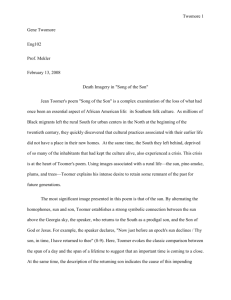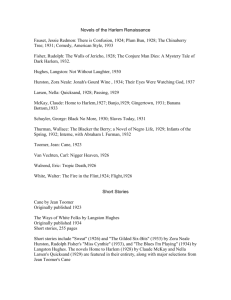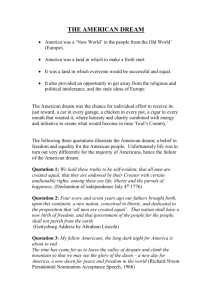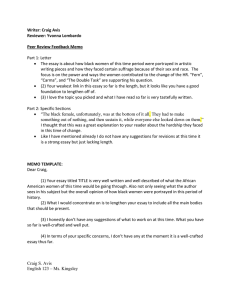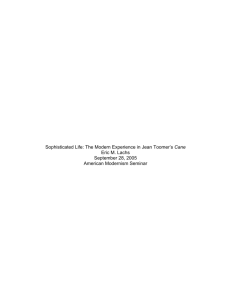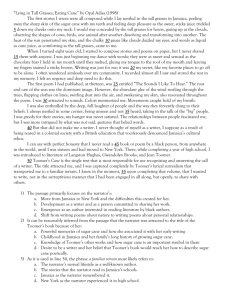Document 13710618
advertisement
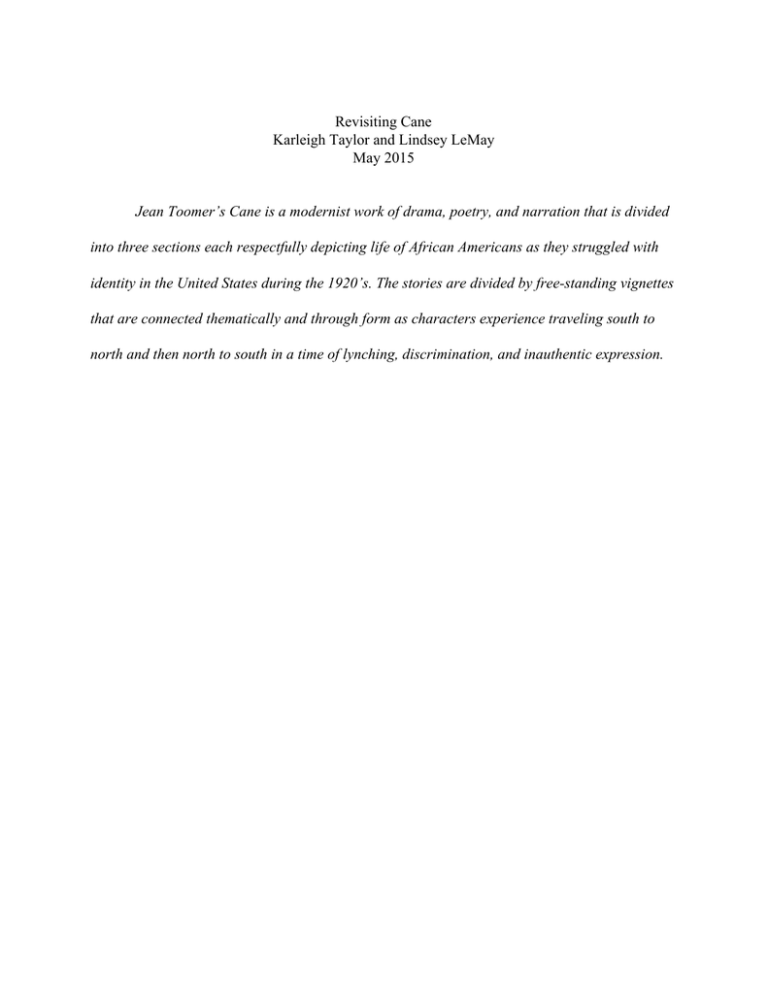
Revisiting Cane Karleigh Taylor and Lindsey LeMay May 2015 Jean Toomer’s Cane is a modernist work of drama, poetry, and narration that is divided into three sections each respectfully depicting life of African Americans as they struggled with identity in the United States during the 1920’s. The stories are divided by free­standing vignettes that are connected thematically and through form as characters experience traveling south to north and then north to south in a time of lynching, discrimination, and inauthentic expression. Throughout Cane, a colon is representative of both characters’ thought and dialogue in a quasi­drama technique that perpetuates the idea of a staged performance (Foley 233). Through this form, Cane encapsulates the non­authentic expression that African Americans were subjected to by a means of acting and/or pretending in fear of being lynched. In the final chapter, “Kabnis”, this form remains while attempting to conclude, or in Toomer’s circular form, prove continuous with the previous sections. However, there are two separate instances when “Kabnis” strays from the rules of the quotation mark/colon binary. At first glance, these may appear to be typographical errors in the edition of the text but upon investigation of the first edition of Cane at the Beinecke Rare Book and Manuscript Library at Yale University, their placement proves to be intentional. The shift in form related to the binary of thought/dialogue and in turn colon/ quotation mark in “Kabnis” supports W.E.B. Du Bois’ theory of “double­consciousness,” the idea that the mind and body are two separate entities which cannot both be authentically expressed. This dilemma of “twoness” and racial duality is proven to have heavily weighed on Toomer himself through the analysis of form and content of “Kabnis”. In The Souls of Black Folk, W.E.B. DuBois stated: …the beauty revealed to him was the soul­beauty of a race which his larger audience despised, and he could not articulate the message of another people. This waste of double aims, this seeking to satisfy two unreconciled ideals, has wrought sad havoc with the courage and faith and deeds of ten thousand thousand people,­­has sent them often wooing false gods and invoking false means of salvation, and at times has even seemed about to make them ashamed of themselves. (DuBois, Of Our Spiritual Strivings) The binary of punctuation found in the first two sections of Cane and the first chapter of Kabnis can be seen as “seeking to satisfy two unreconciled ideas.” Although the character’s true thoughts are expressed in the instances of the (:), they are forced to stay under the surface due to the power of the mind, which is represented by quotation mark surrounded dialogue, controlling the body. This results in Toomer’s character’s being “ashamed of themselves” just as Du Bois suggests. This double consciousness revolves along the “veil of color” that Du Bois characterized as a defining point for African Americans to exhibit “this sense of always looking at one's self through the eyes of others, of measuring one's soul by the tape of a world that looks on in amused contempt and pity. One ever feels his twoness­ an American, a Negro; two souls, two thoughts, two unreconciled strivings; two warring ideals in one dark body, whose dogged strength alone keeps it from being torn asunder” (Du Bois 45). Jean Toomer was of bi­racial descent and ambiguous in appearance. Ralph Kabnis, speculated to be an autobiographical character, was meant to provide both an organic and immediate record of Toomer’s first contact with Sparta, Georgia in 1921 when he returned from the north to work as a substitute principal at The Sparta Agricultural and Industrial Institute in the Oconee River Valley (Scruggs and VanDemarr 127,83). From the beginning of “Kabnis”, it is apparent of the general strife this character faces both personally and socially and how each respectfully influences his fear of being lynched or “outed” for his racial identity. Lynching was thought to be “popular sport” after 1880 and Georgia stood first in the list of states with respect to the frequency of such hate (Scruggs and VanDemarr 137). When the sound of hounds in the night causes an immediate fear to overwhelm Kabnis, he explains, “o God, they’re after me” (126). However, the reoccurrence of the night as a central device in “Kabnis” also exemplifies the rich cultural background that Kabnis acknowledges through the arts. This is indicated by lines such as “dear Jesus, do not chain me to myself and set these hills and valleys, heaving with folk­songs, so close to me that I cannot reach them. There is a radiant beauty in the night that touches and… tortures me” (114). This beauty in the night is of the deeply rooted, rich history of ancestors past and of the bloodshed that occurred and the whispers, by their lonesome familiarity, attest to the Georgia winds being “vagrant poets sing(ing): White man’s land. Niggers, sing . . .” (111). This wind, Kabnis speculates, may also be the sounds of “… so many dead things moving in silence. . . The ghosts down this way haven’t got any chains to rattle, so they drag trees along with them” (116). This passage speaks directly to the story of Mame Lamkins as told by Layman when he explains the gruesome death, “. . . some white man seeing th rising in her stomach as she lay there soppy in her blood like any cow, took an ripped her belly open, and th kid fell out. It was living; but a nigger baby ain’t supposed t live. So he jabbed his knife in it and stuck it t a tree” (124). The motif of trees, representing the ancestral history of Africa, continues through the repetition of the variance of the line “the half­moon is a white child that sleeps upon the tops of pines” (113, 115). This imagery establishes superiority of the white while also suggesting an interesting depiction of the half­moon being representative of the ghostly presence of miscegenation, a sleeping white child atop the trees on which the negro babies are impaled (Scruggs and VanDemarr 141­142). In Jean Toomer’s case, the moon represents a hybrid of his own identity in tandem with the half­moon, both black and white. This dilemma of mixed racial identity in the United States during the early 20th century further verifies Du Bois’ theory of twoness and is voiced in a letter written to Sherwood Anderson, a literary colleague at the time, where Toomer describes his Negro’s curious position in this western civilization invariably forces him into frustrations, “the one or the other of two extremes: either he denies Negro entirely (as much as he can) and seeks approximation to an Anglo­Saxon (white) ideal, or … he overemphasizes what is Negro. Both of these attitudes have their source in a feeling of (a desire not to feel) inferiority” (Toomer, 103­104). He expands on this idea to say that, "In life nothing is only physical, there is also the symbolical. White and Black. West and East. North and South. Light and Darkness. In general, the great contrasts. The pairs of opposites” (Turner, 120). The struggles that Kabnis faces, and in turn his stream of consciousness can be assumed to be the reminiscing of Toomer himself in a time of great duality. The section Kabnis can even be interpreted as a dream of the author, or the hidden authentic expression within a piece focused on extrinsic behaviors expected. For instance, in the first chapter there is a crucial form change that shows this dream state; an open ended quotation mark: “Well I’m damned. This godam place is sure getting the best of me[…] Come now, Ralph, go in and make yourself go to sleep[…]Dont even think nothing. Blank Not even blank. Count. No, mustnt count. Nothing… blank… nothing… blank… space without stars in it. No, nothing… nothing… Kabnis sleeps. (116­117) The presence of the open­ended quotation mark combined with the content that reflects what would generally follow a colon representing stream of consciousness and the repetition of ellipses leading to the word “sleep” all suggest falling into slumber. The open ended quotation mark is the first example of a change in the binary of punctuation, (“)/(:), Kabnis’ monologue before falling asleep doesn’t seem like it is vocalized but (Kabnis:) is replaced with (“). The shift in the binary is a functioning part of this new state of being that exists beginning in chapter two until the second instance of the shift in the binary, represented by another open ended quotation mark. This dream­state is foreshadowed by the statement within the stream of consciousness: “Whoever you are, my warm glowing sweetheart, do not think that the face that rests beside you is the real Kabnis. Ralph Kabnis is a dream. And dreams are faces with large eyes and weak chins and broad brows that get smashed by the fists of square faces… If I could feel that I came to the South to face it. If I, the dream (not what is weak and afraid in me) could become the face of the South. How my lips would sing for it, my songs being the lips of its soul. Soul. Soul hell. There ain’t no such thing” (112). By intrinsically expressing the dream­state of Kabnis, Toomer renders Ralph Kabnis as a work of fiction in comparison to reality. Upon waking from this dream, Kabnis remarks, “He totters as a man would who for the first time uses artificial limbs. As a completely artificial man would. The large frame house, squatting on brick pillars, where the principal of the school, his wife, and the boarding girls sleep, seems a curious shadow of his mind. He tries, but cannot convince himself of its reality” (114). Characters such as Principle Hanby, Kabnis’ supervisor, exaggerate the anglo­saxon ideal Toomer spoke of in his letter to Anderson. As a “a well­dressed, smooth, rich, black­skinned Negro who thinks there is no one quite so suave and polished as himself” (128), his northern persona cast shadows on the Georgia town through his inauthentic “moral superiority.” In contrast, through the arts of prose and poetry, both Toomer and Kabnis aim to give voice to the oppressed in an attempt at unification of past and present, the new “American”. The intraracial division between Hanby and Kabnis demonstrates a lack of unity and clearly distinguishes the restricting duality that Kabnis faces by being both black and white in a society that does not and cannot acknowledge the middle ground. This middle ground is provoked when Principle Hanby confronts Kabnis for his drinking in the classroom. He explains through starting colon: The progress of the Negro race is jeopardized whenever the personal habits and examples set by its guides and mentors fall below the acknowledged and hard­won standard of its average member. The institution, of which I am the humble president, was founded, and has been maintained at a cost of great labor and untold sacrifice… Therefore, if I find your resignation on my desk to­morrow morning, Mr. Kabnis, I shall not feel obliged to call in the sheriff. Otherwise…” (128­129). The ellipses here represent the inexcusability of Kabnis’ race, not his actions, as the social construct of race relations prohibited the transcendence of this mixed race identity toward any possibility other than resignation. In addition, the end quote marks the end of the dream­state mentioned previously as it closes the fictional Ralph Kabnis and marks a pivot in character. This section of the text is the last of educated and eloquent Ralph Kabnis and marks the beginning of Ralph Kabnis as a wagon­wheel repair apprentice, a pre­industrial job, whose dialect turns to the traditional black phonology. This is also exemplified when Kabnis, who had previously been referred to as Professor, is addressed as “young man” (139) by Hanby at the repair shop following his resignation. This language suggests superiority intraracially and further polarizes the social construct of race in the early twentieth century that Toomer himself was so frustrated by. More importantly, the hybridized (:/”) speaks largely to a level of authenticity in Principle Hanby’s words to Kabnis as the consistent playwright is broken and infused with a personal element as represented by the quotation mark. Here, it is important to note that Jean Toomer was indeed an assistant principal at The Sparta Agricultural and Industrial Institute, and not a professor as Kabnis is portrayed. The combination leads to the destruction of the binary where the colon represents stream of consciousness and therefore the body’s wants and quotation marks represent the dialogue and therefore the mind’s power over the body to control what is revealed. This passage is essentially the mind and body being expressed in one thought, the repressed nature in war with the authentic self. This warring leads to the reoccurrence of faces and mouths being in a “twist” or “twisted” of tension is repeated and shown as Kabnis explains,“the form that burned int my soul is some twisted awful thing… and it lives on words… misshapen, split­gut, tortured, twisted words” (151­152).This relates directly to the mind vs. body twoness that Du Bois’ spoke of and the desire for both Kabnis and Toomer to be black and American and to voice through authentic expression, the arts. Toomer never published following Cane, his desire to start a black literary magazine would go unaccounted for, and his ambiguous appearance would later lead him to deny even being black and instead, identify himself as “American” (McKay 174). In the final sentence of “Kabnis”, the common motifs of the pines and a child in the sky reoccur as “the sun arises from its cradle in the tree­tops of the forest. Shadows of pines are dreams the sun shakes from its eyes. The sun arises. Gold­glowing child, it steps into the sky and sends a birth­song slanting down gray dust streets and sleepy windows of the southern town” (160). However, throughout the entire chapter of “Kabnis” and even extending to the previous section of Cane, these motifs have been used to only represent death. The hopeful language of the sun rising and of a birth­song are false glimpses at hope for the unification of modalities between societal acceptance and authentic expression laced by the rooted history of white superiority, defamation, and death of black children throughout the novel (Scruggs and VanDemarr 203­204). In addition to the lack of unity and inauthentic language demonstrated through the conclusion, at the start of “Kabnis” marks two semicircular glyphs seen here that both represent two half moons and quotation marks that hint at forming a complete circle but never meet and VanDemarr 185). This lack of completion extends to both the story of “Kabnis” (Scruggs and the instances of breaking the punctuation binary, represented by the open ended quotation marks, and how there is no synthesis but instead, a further paradox posed. This paradox is the societal duality of black and white and what it means for those who are hybrids, or children of the moon, to find harmony in the consciousness of being both black and American without fear of their racial identity or the stigmas imposed. From the motif of the pines to the repetition of the white child that sleeps atop them, the constant struggle of finding one’s own identity proved to be a struggle for Toomer as portrayed by the character of Ralph Kabnis. This contradiction between the authentic roots of African ancestry, laced with lynching and secrecy, and the joint identity of being “American” were desperately disassociated in spite of Toomer’s wish to unify them for all African Americans.
